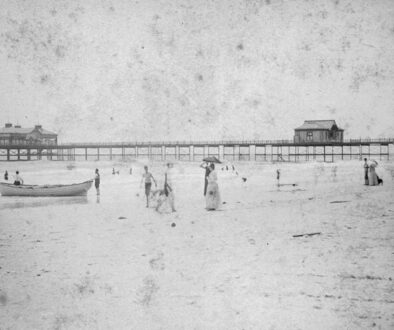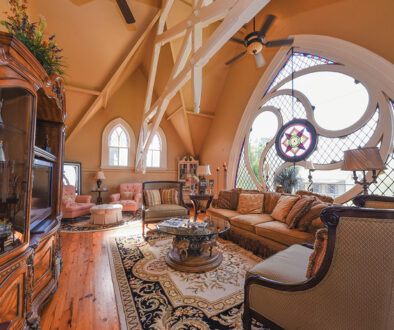Large Craft Advisory
Yank Marine’s Quest for Bigger Boats
Dorchester, New Jersey. On one of those final hot, thick days in early September, late afternoon storm clouds gather over the Maurice River in Tuckahoe. The blue arms of Yank Marine’s newest Marine Travelift soar 65 vertical feet into the air, oblivious to the churning skyline in the background. Comprised of a steel frame and thick canvas straps that span its width, the lift can pluck a ship weighing up to 820 metric tons from the river and hold it suspended for servicing, or move it to another area of the yard by way of its massive wheels. It is the second largest Marine Travelift used in the United States today, outranked only by a 1,000 metric ton model at a shipyard in Norfolk, Virginia.
“We haven’t tested the limit of the lift, but there are alarms on it,” says Bette Jean Yank, Marketing Director at Yank Marine Inc. (their original Tuckahoe location), and Managing Member/Owner at Yank Marine Services LLC (their Dorchester location). Although it can hold a vessel 200 feet long, it’s not just the limit on length that matters; tugboats, for example, are small and compact but heavy.
With this new lift, Yank Marine has the capability of servicing every commercial fishing boat in Cape May, save for one, right here in the Dorchester yard. Prior to the lift’s deployment on November 22, 2017, large commercial fishing boats had no place to go for service in the local area, and had to travel up to 200 miles away if they needed maintenance or repair out of the water. “Think of the costs of traveling those 200 miles,” says Bette Jean, “the fuel, the wages, picking up the crew and dropping them off. When they bring their boat here, we allow the crew to stay onboard and continue working while we are doing the service. We don’t even take it out of the sling. It offers tremendous savings.”

It wasn’t just the limitations of the lift itself in Yank Marine’s Tuckahoe yard, either. “We can lift up to 300 tons there, but if the Tuckahoe River was too shallow for them, or if they couldn’t fit underneath the bridges, we couldn’t service them.”
Vessels aiming for the Tuckahoe yard enter the Great Egg Harbor Inlet and must fit under a series of four bridges that limit the height of vessels to about 50 feet. Up until a few years ago, the Ocean City/Somers Point Bridge and the Route 9/Beesley’s Point Bridge both had drawbridges that restricted the width as well as the height of what could pass underneath.
When Yank purchased the Dorchester yard in 2005, the deeper Maurice River, combined with bridgeless access to the dock, offered an ideal solution for larger vessels. Delivering the $3.5 million lift here required a feat of logistical brilliance, with 17 tractor trailers carrying the components from the Marine Travelift factory in Sturgeon Bay, Wisconsin, navigating the narrow roads, and depositing each part in the sequence it was needed for assembly. The freight alone cost $117,000. To make the most of the convoy of tractor trailers, Yank also disassembled an unused 200-foot lift in the Tuckahoe yard and sent it back to the factory for resale.
Installing the lift marked the beginning of a new era for Yank Marine, the final victory in an arduous 12-year battle to bring the shipyard’s vision for the future to life.
Yank Marine Services in Dorchester
It was a humble beginning for Yank Marine Services LLC when they first bought the Dorchester yard. Abandoned boats in various states of decay lay in repose in the front yard, due to the cost—often thousands of dollars—to get rid of them, between disposal and legal fees.
And then there was the building, which the deed tracks back to the 1920s. “It came with the yard,” says Bette Jean. “We don’t know how old it is or where it came from.” One wall was studded with railroad ties, and all the windows were covered with boards. “I worked on an old Formica table with aluminum chairs,” she recalls. “When somebody came up the stairs, dirt would rain down on my computer keyboard.”
Today, the building exudes the hospitable familiarity of a neighborhood parts shop, with staff members answering the phone at the front desk and ducking amongst rooms filled with all manner of marine repair equipment for sale. “It still rocks when it gets windy,” she adds. “And sometimes, it gets in the way of the lift. We’ve knocked the lights off the building a couple of times.”
The property was a diamond in the rough, but one with tremendous potential. Used by the previous owners to service and store recreational vessels, Yank wanted to focus on commercial and military work. “We started to change the rules because we wanted commercial business like we have in Tuckahoe, but with deeper waters here and no bridges,” says Bette Jean. Although the changes didn’t go over well with the former yard’s recreational customers, the Yank Marine crew knew it was the right direction to pursue, and over the course of the next three or four years, they transitioned to a new set of procedures.
The gamble paid off. “When we took over the yard, the first one I took on was a contract vendor, the Bureau of Shell Fishery fleet. We’d worked on smaller Coast Guard boats, 47s [standard 47-foot motor boats], but nothing bigger. Now we’re going after the big stuff, like a 110-ton Coast Guard boat,” she says. “It’s a little intimidating.”
Getting it Here
Getting a lift this big here was a daunting journey, but the physical challenges paled in comparison to the struggle to secure funding for the new endeavor.
The year was 2008, and banks weren’t lending. Unfamiliar with the industry, they were averse to the risk. “They said they were lending, but then they had so many rules imposed that they took no risk at all. One bank wanted $5 million, and another bank wanted $10 million in collateral,” Bette Jean recalls. “We went to 12 different banks.”
Unlike most other types of equipment, marine lifts hold their value remarkably well. In 2004, for example, Yank traded in a lift they’d purchased 10 years before, receiving almost the price they had originally paid for it. “It’s not like a car,” she explains. “It doesn’t lose millions of dollars when you drive it off the lot.”
And the lift wasn’t the only solid investment. “It’s what we tried to make the banks and the New Jersey Economic Development Authority (NJEDA) understand—it’s not just us,” she says. “We hire people, and we use contractors, painters, carpenters, upholsterers. It invigorates the whole area.”

For Maurice Township, jobs might soon pour in to rival the days when the town was the oyster capital of the world. “While NJEDA offers low-interest loans for building docks, the real jobs will be in building and maintaining the boats.”
The process dragged on until Hurricane Sandy hit, and stronger business loans became available. Bette Jean told their attorney, “I’m not one of the nine impacted counties. But he said, ‘apply for it anyway.’ Lo and behold, the NJEDA took us on. We only ended up borrowing $2 million, with $50,000 as a grant, and the rest as a low-interest HUD loan.”
They were finally able to start construction on the facility, sinking $2.5 million into dredging the area by the dock and installing pilings and a pier—“Everything beneath the ground,” she says. They did what they could with the small 50-ton lift until November 2017, when the new lift made its way down the street.
Origins
The Yank Marine story doesn’t start here on the banks of the Maurice River, however, or even at the original Tuckahoe location. It begins with John Yank’s older sister, with whom he lived after their mother’s death, who ordered the 12-year-old to get a job. He would hop off the bus after school and head over to sweep up floors at Troth Boat Works (now Holtz) in Marmora. When he was 14, they let him use power tools, and from there, John discovered his passion for working on boats, learning his craft from master builders there.
After a stint at Egg Harbor Yachts for seven or eight years, it was time to find a place of his own. A local doctor who owned an old feed barn where he conducted research offered him a small bay, and John started building wooden fishing boats for local fishermen. In 1969, he purchased the property on the Tuckahoe River, building vessels from wood, then fiberglass, and eventually aluminum as the industry evolved.
Nearly a quarter century ago, Bette Jean entered the picture. She was selling real estate when they met. After they married, he suggested she come up and work in the Tuckahoe yard.
Self-promotion was not John’s strong suit. “I’d lived in Upper Township my whole life and never knew how much stuff was coming out of that little yard in Tuckahoe,” says Bette Jean. She finally dragged John to his first trade show, where he landed a new customer—NY Waterways—who hired him to perform a great deal of repair work. “Then they wanted him to build as well as repair,” she recounts. Two years ago, Yank Marine delivered its first 350-passenger ferry to them, a luxurious commuter model that runs from Belford, in Monmouth County, to Manhattan, complete with wifi, airline seats, and a bar used for breakfast on morning trips and drinks on the evening return. Today, three more ferries for NY Waterways are in the pipeline.
The Workers
Bette Jean makes it clear that a job in the shipyard isn’t for everybody. “It’s a dirty job, it’s hard, and it’s all weather. In 100 degrees, they have to put on welding gloves and jackets.” Due to the commercial focus of the business, Bette Jean notes that, “Our guys are not used to working on yachts—they are used to being in greasy grimy fish holes. If they have to take off their shoes to walk across a deck, that could be a problem.”
Yank, like all shipyards in the northern and mid-Atlantic areas, is labor hungry. “We need electricians. We need painters, welders, carpenters,” Bette Jean laments. “They are really few and far between.” Welders need to be certified by the U.S. Coast Guard, and a few of Yank’s current employees entered the business after taking classes in high school, training on the job until they were ready to be certified. Another local source is Cumberland County Technical College, which sometimes sends over graduates of its programs. In the Tuckahoe yard, Yank has even resorted to using hiring agencies to find skilled workers, often sourcing them from shipyards in Louisiana, as well as the apprenticeship program at Southern Louisiana Technical College. But employees from the southern yards generally don’t last long here. “We can’t compete with the Louisiana yards because costs are so much cheaper there,” she says.
Bette Jean’s use of the term “our guys” is deliberate, and accurate: There is a noticeable dearth of female labor in boatyards. In the Dorchester yard, no woman has ever applied for a position, while over in Tuckahoe, John has only ever had one female welder work for him.


Women are not entirely new to the industry, however. In her article “Women Shipyard Workers in the Second World War: A Note” from the August 1989 edition of The International History Review, history professor Deborah Scott Hirshfield explores how the demand for shipbuilding in World War II parted the waters for women entering the industry.
“Women’s jobs most often fell in the helper or labourer categories, which were listed within the traditional craft categories,” writes Hirshfield. “They were not trained through an apprenticeship program, however, but usually learned only the simplest form of welding, down-hand, which could be used in the construction of sub-assemblies. During the war, more welders were hired than any other category of worker, and in some west-coast yards, over forty percent of these were women.”
Prior to 1940, merchant and naval vessels were custom designed and built, a time-consuming and labor-intensive process. The introduction of the Liberty cargo ship, designed by the United States Merchant Marine Commission, ushered in an era of mass production that demanded a sudden influx of semi-skilled labor as well as simple yards in which to quickly assemble the vessels. All-welded ships such as the Liberty, in contrast to riveted ships, could be assembled by a single welder with skills that could be learned in a matter of weeks, as opposed to a traditional four-person riveting team with specialized skills.
Hirshfield found that the employment of women in the shipbuilding industry peaked at 11.5 percent of workers nationally in 1944, coinciding with a peak in the industry itself. “As the battle for tonnage was won, the number in the industry began to decline. Shipyards viewed women’s employment, as they viewed the Liberty ship, as a temporary war measure.”
As veterans rejoined the ranks of civilian workers in the yards, the women found themselves without jobs. “The role of women in the shipbuilding industry during the Second World War thus reflects both the gains and losses experienced by women war workers,” Hirshfield surmises. “While they gained new skills and earned high wages for the first time, they could not maintain their position against the demand for skilled male workers after the war.”
Today, women have a small but definitive presence in the industry. In 2016, the U.S. Department of Labor reports that of the more than 475,000 workers employed in the fields of welding, soldering, and brazing, approximately 26,000 are women. But Bette Jean sees a future here for women. “There should be more women, because I think they would be good at it,” she asserts. “Women can multitask.”
The Future
As Yank Marine looks ahead, they still make time for select vintage projects. “We can still work on the old wood and fiberglass boats, because our guys know how, although we try to stay away from them these days,” notes Bette Jean. One of John’s fiberglass speedboats is still in use in Wildwood, and they are also the repair shop for the A.J. Meerwald, New Jersey’s official Tall Ship, a Delaware Bay Oyster Schooner launched in 1928, but these days only used for educational purposes at the Bayshore Center at Bivalve.
Right now, the Dorchester yard is 100 percent repair, while the Tuckahoe yard is 75 percent repair and 25 percent new construction. Even as they extend their repair operations to larger vessels, they also want to shift over to more building and design work.

One source of new opportunities comes in an unexpected form: offshore wind farms. And due to the Jones Act, all the wind farms being constructed off the east coast must be entirely U.S. owned and built. To correspond with the uptick in these projects, demand for crew transfer vessels—or CTV—is exploding. Used to transport crew to and from the turbine in the ocean in all manner of weather, these boats are specially designed to nudge up against the platform and remain there until service is finished.
“The Europeans are 20 years ahead of us with this technology,” says Bette Jean. For an 8.5 percent licensing fee, Blount Boats offers design plans developed in partnership with South Boats IOW, a UK company that is a leader in Europe’s wind farm industry. She adds, “The installers are going to want the proven European vessels, at first, but we plan to offer two designs.”
Costing seven or eight million dollars to build, the burgeoning CTV market sends ripples out far beyond the initial investment. “Jobs on the shore, jobs on the boats, and jobs repairing the boats,” she says.
Yank Marine is committed to the future. “I married into this,” Bette Jean laughs. “I never imagined I would be selling diesel engines.” Now 78, John Yank doesn’t show any signs of slowing down either.
Who would’ve foreseen that the precocious 12-year-old sweeping floors after he hopped off the school bus would grow his love of watercraft design into a business with two locations perfectly positioned to service the commercial and military industries, adding ships to the waterways and reinvigorating the community along the way?



